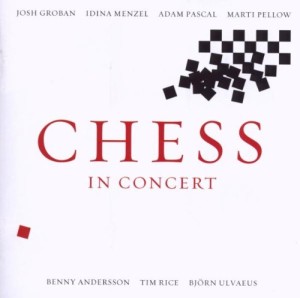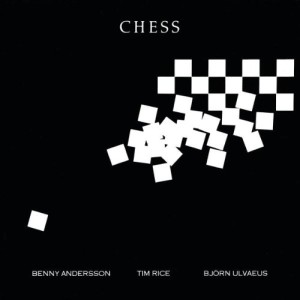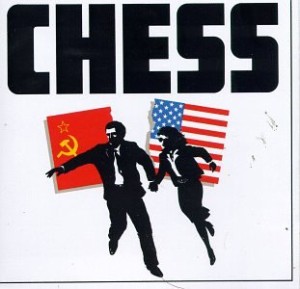I recently went through a few weeks listening to Chess over and over again. This happens every few years when I find a new (to me) recording of the musical, and then I forget about it for a few years until I stumble on another version and the cycle starts again.
I’ve never seen the show. (Update: I finally did!) It took me years to even listen the whole way through. But it’s been on my radar forever. “One Night in Bangkok” was a Top 40 hit when I was around ten. JMS used to open his Babylon 5 convention panels with a music video set to “Nobody’s Side.” The solo songs were immensely popular in my college musical theater classes: The guys who were serious about it all wanted to sing “Anthem” (can you blame them?), and I lost track of how many times I heard “Heaven Help My Heart,” “Someone Else’s Story,” and “I Know Him So Well.”
For those unfamiliar with the show, it’s about the personal rivalry between American and Soviet chess champions and the political machinations surrounding a world chess tournament during the cold war.
Contrast
One of the things I find fascinating about Chess is that it’s got two very distinct musical styles: timeless classical, and glaringly 80s synth pop, sometimes both within a song. Listen to parts of “Merano” or “Mountain Duet” or even “Anthem” and you’d be hard-pressed to say what decade they were written in. “You and I” sounds like it could be part of a 1930s movie soundtrack. But “One Night in Bangkok,” or “Pity the Child,” or “Nobody’s Side?”
Totally 80s!
After listening to the concept album, the Broadway cast album, and Chess in Concert, I’ve come to realize why it’s done that way, and why it works. The show is about duality and contrast: American vs. Soviet, East vs. West, and of course the ancient civilized game of chess and the very modern lives of those who play it.
80s synth-pop is not only perfect for the time it was written and is usually set, it offers a perfect contrast to the classical sound. You could probably update the arrangement on “I Know Him So Well” if you really want to, but what are you going to do with “One Night in Bangkok?” Or going back to “Mountain Duet,” the jump from slow, beautiful melody to jarring hard rock brings the tension from the background to the front of the scene.
Comparison
 Musically, my favorite is the original concept album. The overall sound just works better for me, though it’s hard to follow the choral numbers.
Musically, my favorite is the original concept album. The overall sound just works better for me, though it’s hard to follow the choral numbers.
The best thing about the Broadway version is Judy Kuhn. She’s amazing, and the expanded role for Florence gives her plenty of opportunities to shine. A few of the orchestrations work better too – “Heaven Help My Heart” is better without the echo, for instance. But while Philip Casnoff is good on most of the recording, he just sleepwalks through “One Night in Bangkok.” Maybe it’s a character choice that works on stage, but isolated as audio it just can’t compare to Murray Head.
The concert version has the clearest story to it, and the additional songs are fascinating for the additional layers they add. Adam Pascal and Josh Groban are great, and I like that they cast two actresses with very different voices for Florence and Svetlana. (Funny that they’re both known for playing Elphaba.) Strangely enough, Idina Menzel almost sounds too soft here (how did that happen?), but she’s grown on me as I’ve listened through a few more times.
Plus I had this great idea to do a fan video using her version of “Nobody’s Side” for Frozen.
I’ll probably never get around to it, but wouldn’t it be awesome? Or at least *ahem* cool?”


